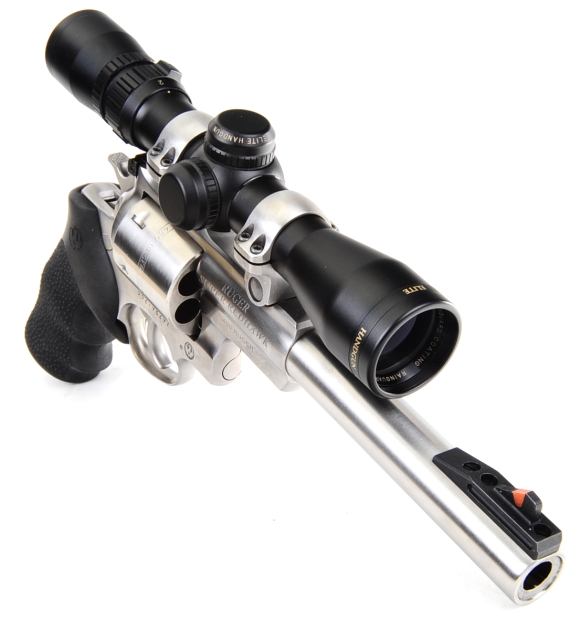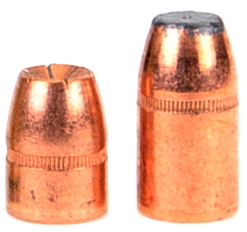
The 480 Ruger and Ruger Super Redhawk are an interesting, well thought out and effective hunting combination. Well made, solid performer in terms of accuracy and power and a lot of fun to shoot. In fact, with a set of dies and come components, it could represent a lot of experimentation and hunting skill development. None of this comes without its challenges, much of it related to ammunition, and much of that related to its relatively unique 0.475″ bullet diameter.
To the best of my knowledge, there are only two generally available cartridges in this handgun caliber, the 480 Ruger and the 475 Linebaugh, the latter with approximately 8% greater capacity than the former. Both cartridges are controlled under a SAAMI homologation,The 475 Linebaugh operates at a higher Maximum Average Pressure at 50,000 PSI, compared to 48,000 for the 480 Ruger. Performance ammunition, at the 300 grain bullet weight, gives approximately +250 fps to the Linebaugh. At the heavy end, +400 grain factory ammo, the Linebaugh edge drops to +200 fps. Sounds great for the 475 Linebaugh, until you shoot one and experience the thrill of 475 Linebaugh recoil and muzzle blast.
In terms of factory ammunition, there are two loads available for the 475 Linebaugh and five for the 480 Ruger, subject to then current trends. For the Linebaugh they are Underwood and Buffalo Bore, one each, bullet weights 300 grains and 420 grains respectively. For the Ruger; Buffalo Bore, Grizzly, Hornady, and Underwood in bullet weights between and including 300 grains to 425 grains. Cost per round for the Linebaugh is $3.00 and $2.90 per round. The Ruger ammo runs $1.52 to $2.85 per round. Neither are for the frugal sportsman but, if your marksmanship skills are what they should be, one shot should get it done and handloading makes for considerably lower shooting costs.
 There are… or at least were until very recently, nine 0.475″ bullets from a group of six manufacturers generally available; Three cast, two monolithic copper alloy, four jacketed lead; 275 grains to 410 grains within the group. I selected two, the 275 grain and 400 grain Speer DeepCurl. Unfortunately, the 400 grain DeepCurl, has gone obsolete… apparently while I was typing.
There are… or at least were until very recently, nine 0.475″ bullets from a group of six manufacturers generally available; Three cast, two monolithic copper alloy, four jacketed lead; 275 grains to 410 grains within the group. I selected two, the 275 grain and 400 grain Speer DeepCurl. Unfortunately, the 400 grain DeepCurl, has gone obsolete… apparently while I was typing.
The 275 grain bullet is a great example of what happens when a comparatively light weight bullet is shoved down the barrel of a big bore revolver with a not inconsiderable amount of pressure. The 400 grain bullet makes for a good examination of what happens to a heavyweight bullet under the same circumstances.
The 275 grain is made for 480 Ruger velocity levels, this specific 400 grain bullet is… was actually made for the 475 Linebaugh and would not be expected to expand effectively at 480 Ruger velocity levels. Alternatives? Sure. On the lighter end and mid range spectrum of 0.475″ bullet weights, Barnes offers an expanding copper alloy expanding 275 grain bullet, both Speer and Hornady offer a 325 grain JHP and Lehigh Defense offers a 330 Grain solid copper flat nose. Missouri Bullet makes a plain and coated 325 grain cast bullet and Cast Performance makes a 410 grain hard cast which is also loaded in Buffalo Bore loaded ammunition.
Once fired Hornady Brass was used for all handloads with no special prep or processing. After trying a variety of smokeless powder, I settled on using four types: H110, W296, Lil’ Gun, and Alliant 300 MP. I was going to work up some reduced loads… maybe another time. Both Hornady and Starline produce new brass as components. What if brass runs out? If you’ve been handloading for a while and have fabricated cases, 480 brass can be made from 45-70 brass. Shortening, expanding and sizing, inside case reaming, and rim size reduction… turning. And what is they stop making 45-70 brass? That would mean shooting sports and handloading has ceased to exist. Get familiar with the terms leaching and electro winning.
Handload Data
Warning: Bullet selections are specific, and loads are not valid with substitutions of different bullets of the same weight. Variations in bullet length will alter net case capacity, pressure and velocity. Primer selection is specific and primer types are not interchangeable. These are maximum loads in my firearms and may be excessive in others. All loads should be reduced by 5% as a starting point for development where cartridges have greater than 40 grains in capacity and 10% for cartridges with less than 40 grain capacity following safe handloading practices as represented in established mainstream reloading manuals. Presentation of these loads does not constitute a solicitation for their use, nor a recommendation.
| Cartridge 480 Ruger |
|
| Firearm | Ruger Super Redhawk |
| Barrel Length | 7.50″ |
| Min – Max Case Length | 1.285″ +0.000″/-0.015″ |
| Min – Max COL | 1.550″ – 1.650″ |
| Primer | CCI 300 |
| Bullet Diameter | 0.4755″ +0.000″/-0.0030″ |
| Reloading Dies | Lee Precision |
| Bullet Type | Bullet Weight Grains |
Net H2O Grains Capacity |
COL” | Powder Type | Powder Charge Grains |
Muzzle Velocity FPS |
Muzzle Energy ft/lbs |
50 YD 3 Shot Group “ |
| Speer Deep Curl HP | 275 | 30.3 | 1.640 | Win 296 | 34.0 | 1473 | 1325 | 1.6 |
| Speer Deep Curl HP | 275 | 30.3 | 1.640 | H110 | 34.0 | 1481 | 1340 | 1.5 |
| Speer Deep Curl HP | 275 | 30.3 | 1.640 | 300 MP | 38.0 | 1706 | 1778 | 1.7 |
| Speer Deep Curl SP | 400 | 18.9 | 1.640 | Win 296 | 21.0 | 1062 | 1002 | 1.6 |
| Speer Deep Curl SP | 400 | 18.9 | 1.640 | Lil’ Gun | 20.0 | 1078 | 1032 | 1.3 |
| Speer Deep Curl SP | 400 | 18.9 | 1.640 | 300 MP | 24.0 | 1165 | 1206 | 1.6 |
Epilogue… Maybe a monologue
 The combustion on the once fired cartridges is leakage and stops short of the case head and interior web. There was no sign of leakage past that point, on the rear of the cylinder or on the recoil shield. Cylinders checked minimum SAAMI spec: 0.506″ ahead of the rim, 0.505″ halfway in, 0.504″ at the case mouth position, 0.475″ at the throat. Factory ammo on first fire had the same combustion discoloration pattern. My guess is that this is the typical chamber expanding associated with big bores and high chamber pressure. Supposition on my part.
The combustion on the once fired cartridges is leakage and stops short of the case head and interior web. There was no sign of leakage past that point, on the rear of the cylinder or on the recoil shield. Cylinders checked minimum SAAMI spec: 0.506″ ahead of the rim, 0.505″ halfway in, 0.504″ at the case mouth position, 0.475″ at the throat. Factory ammo on first fire had the same combustion discoloration pattern. My guess is that this is the typical chamber expanding associated with big bores and high chamber pressure. Supposition on my part.
I did not wander too far from component manufacturer provided data. As an example, the 300 MP loads coincide with Alliant Powder’s Reloader’s Guide, but the data here is adjusted to trimmed brass and are 0.010″ shorter in COL. The 275 loads were checked against Speer #15 data. They are maximum and I would caution to follow the warning above the handload data.
Experience with larger and higher pressure revolver cartridges would label recoil as not as bad as some. The 300 MP loads are… eye opening with a good deal of smoke and muzzle flash and they are muzzle raising. For as much as they are fun to shoot, I would think they aren’t a level of velocity necessary for hunting. The other loads would easily get the job done and they are more manageable. For me, the Super Redhawk was more manageable than the five shot Super Blackhawk and similar revolvers. And so we will put the big Ruger Super Redhawk up until next time…

Email Notification